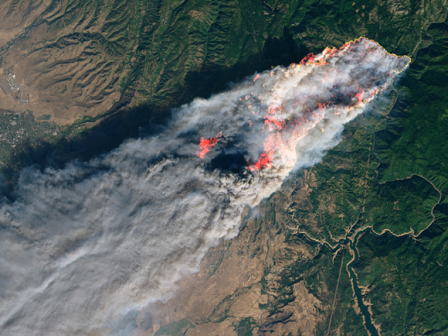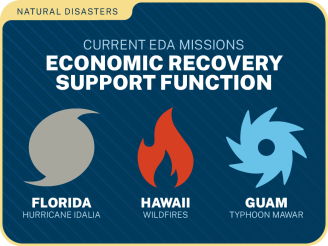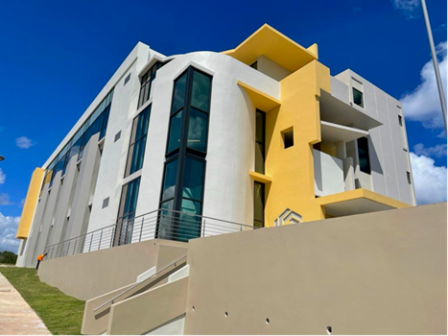
When Disasters Strike, EDA is There for Communities
“The country is here for you and with you. We are not leaving until things are built back and built back better than they were before...We’ll be with you every step of the way.”
President Joe Biden visiting Santa Cruz County, California after severe storms & flooding | January 2023
The U.S. Economic Development Administration (EDA) plays a unique role in assisting communities when catastrophe strikes. As the only federal agency focused solely on economic development, supporting a community facing a significant, potentially devastating, economic event following a natural disaster is a critical role EDA is proud to support.
Following the immediate triage after a disaster, federal partners work collectively to assist in both short- and long-term disaster recovery. EDA leads the Economic Recovery Support Function, which is part of the FEMA-led National Disaster Recovery Framework that supports local, state, and Tribal governments rebuild businesses and employment, and create economic opportunities to develop resilient communities. Our team works on the ground helping communities navigate federal revenue streams and envision a stronger future.

Disaster recovery, much like traditional economic development, is not a one-size-fits-all approach. EDA’s place-based, locally led economic development approach and its existing network of national and regional partners—including Economic Development Districts (EDDs), University Centers, and other stakeholders—ensures disaster-affected communities receive necessary support and investment.
EDA believes the best economic success stories come from direct engagement with communities, keeping their recovery efforts locally driven. This ensures the right help gets to the right people when it is needed most. Sometimes what a community needs most after a disaster is to know they are being seen and heard.
“[EDA] came to us and asked, how can we support you?... To be there and to have a person answer those questions is completely mind blowing when it comes to disaster recovery. We had colleagues come from hours away to attend,” said Chelsea Irvine of 3CORE, following EDA’s support for California communities affected by the 2021 wildfires.
EDA’s History of Disaster Supplemental Funding
Since the early 1990s, Congress has appropriated approximately $3.2 billion to EDA to support disaster recovery and resilience. This funding has resulted in hundreds of grants to communities across the country that have been affected by federally declared natural disasters.
EDA received much of the disaster supplemental funding in the last six years through three specific opportunities, including two supplemental appropriations that provided $587 million each for communities affected by natural disasters in 2017 and 2018, and tornadoes and floods in 2019.
The investments support a variety of projects including infrastructure improvements to prevent future flooding, workforce development to create jobs, and Revolving Loan Funds to provide support to small businesses.
Just one example can be seen in Puerto Rico: a $4.4 million disaster supplemental investment is spurring innovation and entrepreneurship on the island after it was hit by back-to-back hurricanes in 2017. The funding helped to create the Forward Center, a 30,000-square foot STEM facility that can house up to 50 startups focused on science, technology, and manufacturing. Leaders say the center will help citizens who lost their jobs after the storms to start businesses of their own.

READ MORE: EDA Supports STEM Technology Development in Puerto Rico Following Irma and Maria
Meanwhile, following a devastating wildfire in Paradise, California, leaders leveraged EDA disaster supplemental funding to secure additional federal funding for the community. The 2018 Camp Fire is recorded as the single most devastating fire in California state history, killing 100 people and destroying 90 percent of homes in the area.
EDA provided a $1.8 million investment to support development of a master plan to guide recovery and redevelopment of the community’s transportation infrastructure. Less than two years later, that planning and scoping allowed the city to qualify for a $200 million Community Development Block Grant-Disaster Recovery from the U.S. Department of Housing and Urban Development. Community officials credit the EDA investment. “There is no way the town would have been able to respond in the absence of the EDA grant. It’s been such an important part of our recovery curve,” Paradise City Engineer Marc Mattox said.
READ MORE: Paradise, California Leverages $1.8 Million EDA Grant to Secure $200 Million Investment
Newly Announced Disaster Recovery Investments
EDA is currently accepting applications for its most recent disaster supplemental appropriation, the FY23 Disaster Supplemental, which provides $483 million to communities affected by natural disasters in 2021 and 2022. Funds are awarded on a rolling basis and can be awarded to assist a wide range of disaster recovery, including economic recovery and resilience strategic planning grants and public works construction assistance.
Recently, EDA has announced awards from the appropriation to the city of Roseau, Minnesota for stormwater infrastructure improvements, creation of a business incubator to support workforce development at the University of Texas Rio Grande Valley, and reconstruction of an airport terminal destroyed by a tornado in Jonesboro, Arkansas, among others.
MORE: Recently Announced FY23 Disaster Supplemental Awards
As more natural disasters inevitably occur, so does the need for disaster recovery support so communities can build stronger for the future. EDA’s impact is evident through immediate economic recovery coordination, funding for strategic planning, economic recovery, and long-term resilience and preparedness, and our team stands ready to help states and communities deal with future disasters and emergencies.
For more information on EDA’s Disaster Recovery & Resiliency Efforts, visit eda.gov.
